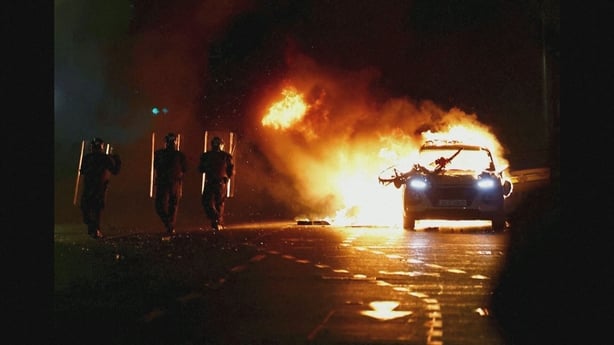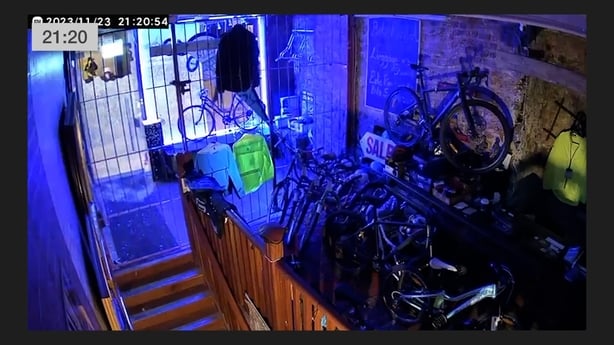RTÉ's Prime Time programme has analysed hours of CCTV and video footage from the rioting that gripped Dublin two weeks ago, in the process piecing together a moment-to-moment timeline which sheds more light on how they developed across 23 November.
The riots raised serious questions for politicians and An Garda Síochána management around policing, public safety, and the threat of Irish anti-immigration campaigns.
The timeline also shows how key events happened later than have previously been reported elsewhere.
Watch the full report here:
Footage obtained confirms that the Luas tram which was torched on O’Connell Street was set alight while public order gardaí were just metres away.
The tram - valued at €5m - and attached power lines, were just some of the millions of euro worth of property destroyed city-wide.
Prime Time confirmed that the fire on the Luas was lit at exactly 7.25pm, nearly two hours after a crowd of people pushed through the crime scene cordon on Parnell Square East, and a garda was punched.
Garda management has rejected criticism around the urgency of its public order response.
In a statement in the days following the riots, it said it implemented a 'Public Order Incident Command Policy.’
Prime Time asked An Garda Síochána a series of questions in relation to when key decisions were made during the riots, including when the policy referred to was implemented. Garda management refused to provide such details.

Timeline: 23 November
When three children and their female carer were attacked outside a school on Parnell Square on 23 November just after 1.30pm, posts and messages quickly started to appear across Irish social media.
By using bespoke online search systems to analyse social media activity, Prime Time also compiled a picture of how sentiment developed online in relation to the attack.
Within thirty minutes of the attack, posts speculating about the condition of the victims and the nationality of the alleged suspect began circulating on X, formerly Twitter, and on Telegram channels focused on nationalism and immigration.
This was prior to media publishing breaking news stories about the incident.
While anger was beginning to build online, a small crowd of onlookers was gathering at the crime scene cordon on Parnell Square. Over the following hours video footage shows the crime scene was relatively quiet, but social media posts show speculation and anger continued to grow online.
By 4.45pm, the mood of the crowd around the crime scene had changed. In the intervening hours, several people who have previously been prominent at anti-immigration protests had called for people to meet at the Spire at 7pm.
Elements within the crowd at the crime scene pushed through the cordon at 5.42pm, and a garda was punched soon afterwards. This sparked chaos around the Parnell Street area.
At 6.21pm, a small group of gardaí from the Public Order Unit were attacked and outnumbered by a crowd on Parnell Street, who soon set a garda vehicle on fire.
Around the same time, people were arriving into the city and meeting at the Spire, finding growing unrest around the O’Connell Street area.
At approximately 7.07pm, a lone garda was attacked on O’Connell Bridge. Subsequently, a garda vehicle which had been left at O’Connell Bridge was torched by the crowd, as well as a Dublin Bus.
At other points in the night, the video compiled and timecoded by Prime Time also shows looting and criminal damage happened in areas where garda Public Order Units had passed through.
Public Order Units responded to looting on Henry Street and Mary’s Street at approximately 8.30pm. Video recorded minutes later shows some people resumed looting in the same shops after gardaí left.

An Garda Síochána did not provide details as to when key operational decisions were made.
It says that "by 6pm" on the day of the rioting two garda Public Order Units were "operational," the equivalent of 50 public order gardaí.
It says "from 6pm" additional garda public order resources "were requested from the wider Dublin Region and other Garda Regions."
Garda management said it implemented a ‘Public Order Incident Command Policy’ during the rioting.
Garda management did not provide details as to when exactly that policy was implemented.
Additional public order deployments arrived in the city "between 7pm and 9pm," garda management said.
Speaking before the Joint Committee on Justice on 29 November, Garda Commissioner Drew Harris said there was a "significant garda presence" in the city by 7pm.
The timeline compiled by Prime Time shows the Luas tram was set alight at 7.25pm. Looting of the Foot Locker shop on O’Connell Street started at 7.41pm.
Footage obtained by Prime Time shows individuals smashing the front of shops on Capel Street and Parliament Street between approximately 9.15pm and 9.30pm.

Over this period, gardaí were struggling to restore order. Footage from approximately 8.12pm shows a garda with a lower leg injury being assisted to walk by colleagues behind garda lines.
By 8pm, the number of public order gardaí had grown to 250, Commissioner Harris said, making it the force’s "largest ever public order deployment."
Commissioner Harris said calm had been "largely restored" to the city centre by 10.30pm and fully restored by 11.30pm.
The timeline given before the Oireachtas Committee differed somewhat with an earlier statement given by Commissioner Harris on the morning of 24 November. Then he said "order was restored" to the city between around 8.30pm and 9pm.
Gardaí have since made 34 arrests in connection with the riots, looting and violence.
Dublin City Council estimates that between 5.45pm and 10.45pm almost €20m worth of damage was done in the area.
‘Unfolding Chaos: How Dublin’s Riots Developed’ is a special project produced by the RTÉ Current Affairs Digital Unit for RTE.ie. It can also be watched on YouTube here.

